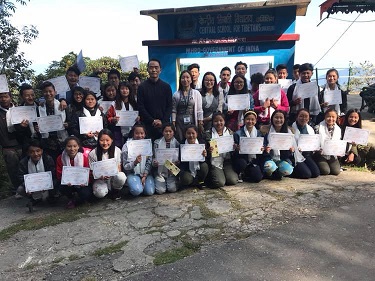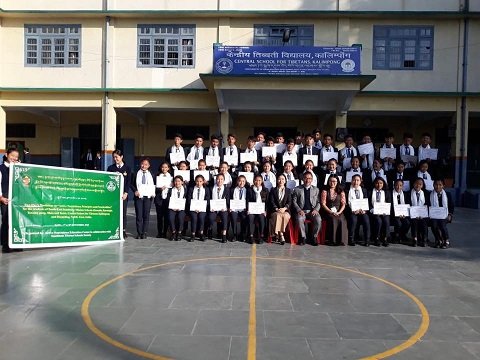TABLE OF CONTENTS.
- Introduction of Active Nonviolence Education Center.
- Concept of Nonviolence and Violence.
- Nonviolent Communication, a method of conflict resolution.
- Meaning of power, its types and sources. The role of power sharing in Schools.
- The concept of obedience.
- Why Tibetan should follow the path of Nonviolence?
- Chinese Pillars of Supports.
- 198 methods of nonviolent action introduced by Dr. Gene Sharp.
WORKSHOP FACILITATORS:
Tenzin Lhamo (Executive Director-ANEC)
Tenzin Lhaze (Assistant Trainer cum Teaching Officer-ANEC)
METHODOLOGY:
- Power point presentation
- Role Play
- Discussion
- Charts
- White board
- Brain stroming
- Feedback
MEDIUM OF COMMUNICATION:
Tibetan, English and Hindi (When needed to make them understand better).
MATERIALS DISTRIBUTED:
- Notepad, Pen, Certificates.
- ANEC’s Introductory Brochures.
- ANEC’s 14th Newsletter.
- Copies of 198 methods of Nonviolent action introduced by Dr. Gene Sharp.
- Material based on four components of Nonviolent Communication as an exercise to understand better.
AIMS AND OBJECTIVES OF THE WORKSHOP:
- To impart deeper understanding on Nonviolence and why it is considered as an indispensable tool in establishing peaceful society and overthrowing rigid policy of any government.
- Introduced “Nonviolent Communication” and its usage in interpersonal relation to foster compassionate response from the opponent as well as listening with whole being towards the needs and feeling of other and as well as ours.
- Provide education on the weakness and the strength of Chinese Pillars of support and what are the reasons for why Tibetans should follow the path of Nonviolence?
- To familiarize the concept of power and the role of power sharing in schools and why obedience is considered as the heart of political power.
- To make them aware of the availability of 198 Methods of Nonviolent action to make any nonviolent movement more effective.
Darjeeling – DAY ONE (10:00 AM TO 1:00 PM)
Kalimpong- DAY ONE (4:00 PM TO 7:00 PM)
The two-half day workshop on Nonviolence Principles and Practicalities was inaugurated by concerned Rector of each school by welcoming ANEC’s facilitators. They reminded the participants that the Nonviolence is the only effective way to gain attention regarding the plight of any country and it is the only way to resolve conflict between countries and individuals. They therefore, urged all the participants to learn more about nonviolence and its methods and try to implement in their lives for effective result.
Ms. Tenzin Lhamo, Executive Director gave a detailed introduction about ANEC and how it was successfully institutionalized under the guidance of His Holiness the 14th Dalai Lama and the relentless efforts Rabbi Everett Gendler and Dr. Mary Gendler. She expressed the workshop to be resourceful and effective for the participants.
ANEC Documentary film- A journey of Nonviolence; Alabama to Dharamshala was screened.
Ms. Tenzin Lhamo divided the participants into five groups and asked each group to write down their ideas of nonviolence and violence in words and further form it into sentences.
Subsequently, two participant representing from each group read out the sentences they formed and explained. On the other hand the exercise provide them a platform to think on their own regarding nonviolence and violence. Hence, they all came up with realistic and logical definitions of Nonviolence. Ms. Tenzin Lhamo further explained both the meanings of Nonviolence introduced by some of the world’s pacifist leaders like, Mahatma Gandhi, Dr. Martin Luther King Jr. etc. for their in-depth understanding on terms.
Ms. Tenzin Lhaze gave a power point presentation on four basic components of Nonviolent Communication to develop their communication skill, to strengthen their relationships and to make them aware about availability of the powerful methodology for communicating in a way that meets the need of both parties. It brings a more loving, compassionate, and nonviolent way of understanding and functioning with others. It basically shows us how to listen emphatically and also communicate our authentic feelings and needs.
Ms. Tenzin Lhamo gave a detailed power point presentation on power, types of power and its sources. She further talked about the role of power sharing in schools and it is mendatory to share power amongst students rather than to hold at top in order to develop a sense of belogingness and to give authorty to take responsibilities by their own.
Darjeeliing – DAY TWO (10:00 AM TO 1:00 PM)
Kalimpong – DAY TWO (4:00 PM TO 7:00 PM)
Ms. Tenzin Lhamo gave a power point presentation on the topic ‘Reasons for Nonviolence and Why Tibetans should follow the path of nonviolence.’ She reasons out that Tibet is economically, militarily and demographically incompetent in terms of war with Chinese for Chinese economic, population and military power is growing each day. Hence, making it incompatible for Tibetans to retaliate and resorting to violence could bring unprecedented destruction for the Tibet and its People.
Therefore, Nonviolence and renouncing to violence is the realistic steps to challenge the Chinese authoritarian regime. She further stated nonviolent strategy stops the unending cycle of violence. It is a tools that can be practiced by anyone regardless of age, sex, gender, lay people and monk. Finally it is path strongly advocated by His Holiness the 14th Dalai Lama in the course of Tibetan struggle for justice.
We had distributed copies of 198 methods of nonviolent action coined by Dr. Gene Sharp as result of his lifelong research on successful nonviolent movement around the world in order to make them understand about three sub categories;
1. Protest and persuasion,
2. Noncooperation
3. Nonviolent intervention through skit in which some students played the role of oppressor and oppressed, some played the role of protest and persuasion, some used noncooperation methods to withdraw their support and the rest used nonviolent direct intervention in order to de-escalate conflict and render justice. The aim of doing skit is to familiarize three methods of nonviolent action more effectively.
The divided participants were directed to present a short skit on protest and persuasion, Noncooperation and intervention respectively.
Feedback forms were filled by the participants and collected accordingly. We classified feedback in two parts as constructive feedback and positive feedback.
CONCLUSION-
Concerned Rector of each schools’ addressed the closing ceremony where he thanked workshop facilitators and offered white scarf.
Ms. Tenzin Lhamo and Rector offered white scarfs and certificates to all the workshop participants as a token of gratitude for their dedication and participation throughout the workshop.
Ms. Tenzin Lhamo thanked Rector for the hospitality and offered white scarf and ANEC 11th founding anniversary followed by Group Photo.

PHOTOS- CST DARJEELING AND KALIMPONG,
WEST BENGAL.

PHOTOS- CST DARJEELING AND KALIMPONG,
WEST BENGAL.
THE END

